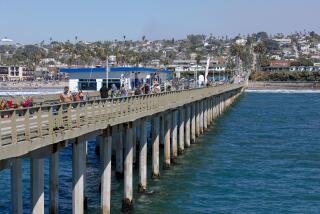AQMD Critical of Port Plan to Grow
- Share via
Long Beach port commissioners approved a 115-acre expansion plan last month even though smog regulators warned them that the harbor’s environmental review underestimated how much air pollution would be generated by trucks and other vehicles.
Air pollution has emerged as the central issue in the debate over whether to expand a pier near the Queen Mary. Critics of the plan point out that the Los Angeles and Long Beach ports are already the single largest source of air pollution in Southern California and that the new berths would simply make the problem worse.
Officials at the South Coast Air Quality Management District said that they informed port officials in letters in October 2003 and again this July that its calculations of future air pollution were inadequate, but the port still used those calculations in environmental documents to support the expansion of Pier J. Susan Nakamura, AQMD planning and rules manager, reiterated the agency’s concerns at a Long Beach City Council meeting Tuesday.
After hearing Nakamura’s comments, the council abruptly postponed until November a final decision on whether to sign off on the Pier J project.
“When you’ve got AQMD coming out in two separate letters saying you’re inadequate, and you’re ignoring it -- that was the most damaging thing,” said City Councilman Val Lerch, a critic of the proposal.
Port officials maintained Wednesday that their calculations were sound. The AQMD letters were sent by the air agency’s planning and regulatory department, but port administrators said they received guidance from other AQMD staff members.
“We’re very concerned that we have an agency that we’re depending on for guidance and we’re not getting consistent information,” said Robert Kanter, the port’s planning director.
Kanter also said he was puzzled by what he called the “eleventh-hour” testimony from Nakamura.
In its letters, the AQMD took issue with the port’s assertion that the harbor would eventually see a 75% reduction in diesel particulate matter from vehicles. That decrease will occur only in new trucks meeting federal standards being phased in beginning in 2007, air officials said. Even though many old trucks will remain on the road long after the standards take effect, the port seems to be assuming that all trucks entering the port after 2007 will have the new, cleaner engines, the AQMD said.
The port’s environmental documents “did not provide any enforceable commitment to ensure this level of control would occur at the project site,” one letter said.
Addressing the council on Tuesday, Nakamura said the AQMD believes its concerns “were not adequately addressed” by the port and that the environmental report underestimates certain emissions.
The battle over Pier J reflects an emotional debate about growth at the Los Angeles-Long Beach port complex, the busiest in the United States.
Residents of the harbor area and along major area freeway corridors blame the port for increased air pollution and traffic congestion.
That debate escalated after USC scientists released the results of two studies in the last two weeks, one reporting on unexplained pockets of cancer downwind of the port, and the other on the loss of lung function in children in six cities with dirty air, including Long Beach.
One resident of Camden Harbor View, a new residential development overlooking the port in the city’s downtown, took the podium Tuesday night and pulled a soiled rag out of a plastic bag.
The dirt on the rag had accumulated in one week on a terrace off his living room, David Carden Jr. told council members.
“Just think what it must be doing to our lungs when we breathe,” Carden said.
A total of 28 people addressed the council, with most residents criticizing the project; union members and port businesses praised it.
Supporters said the project would create more high-paying dock jobs. One member of the pipe fitters union said that an estimated 500,000 people recently applied for 3,000 new jobs at the port.
Lawyers from the Natural Resources Defense Council spent nearly an hour critiquing what they called flawed assumptions and calculations throughout the environmental impact report. Port officials, in turn, said the public may be misunderstanding the intricacies of port operations.
More to Read
Sign up for Essential California
The most important California stories and recommendations in your inbox every morning.
You may occasionally receive promotional content from the Los Angeles Times.










